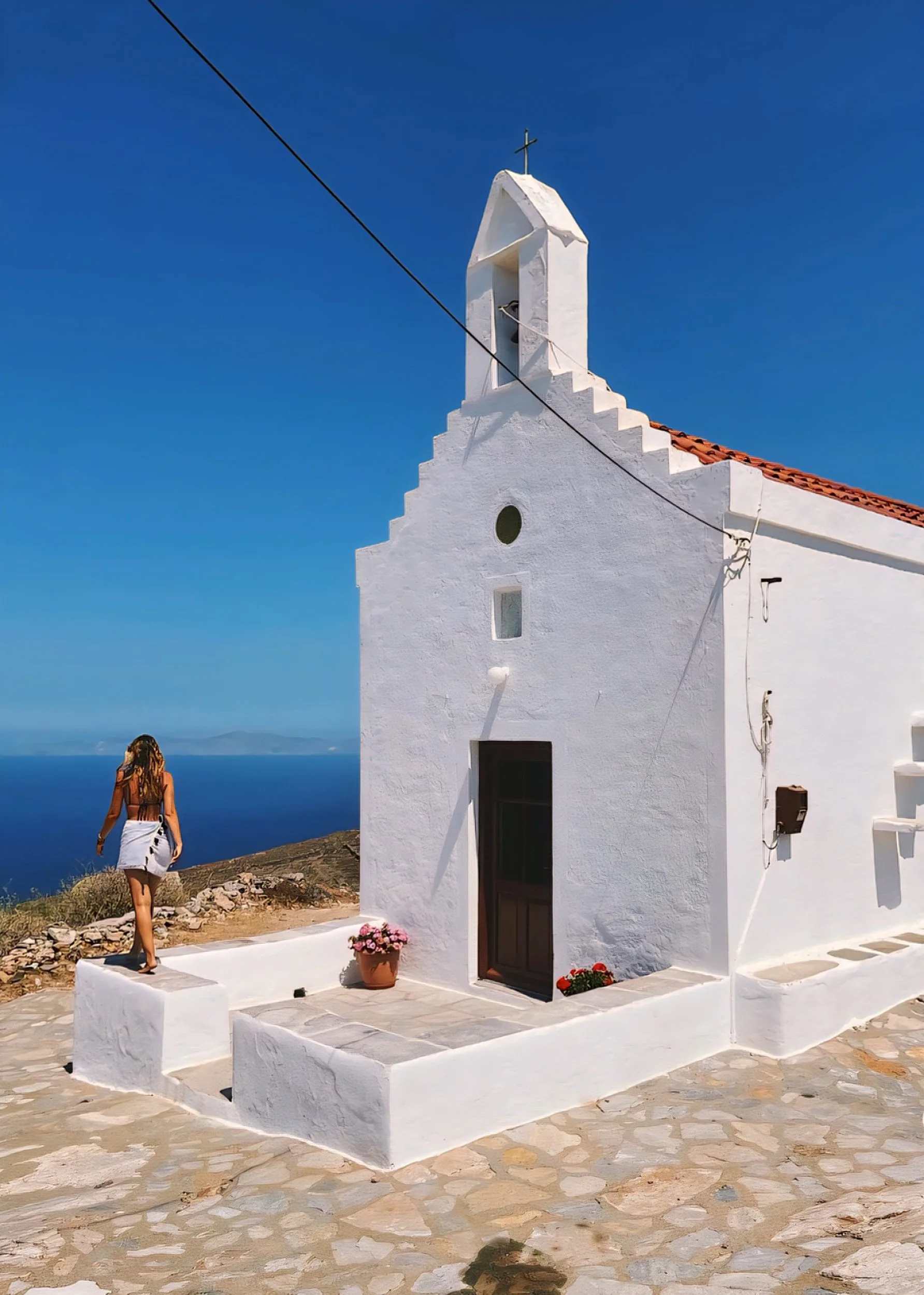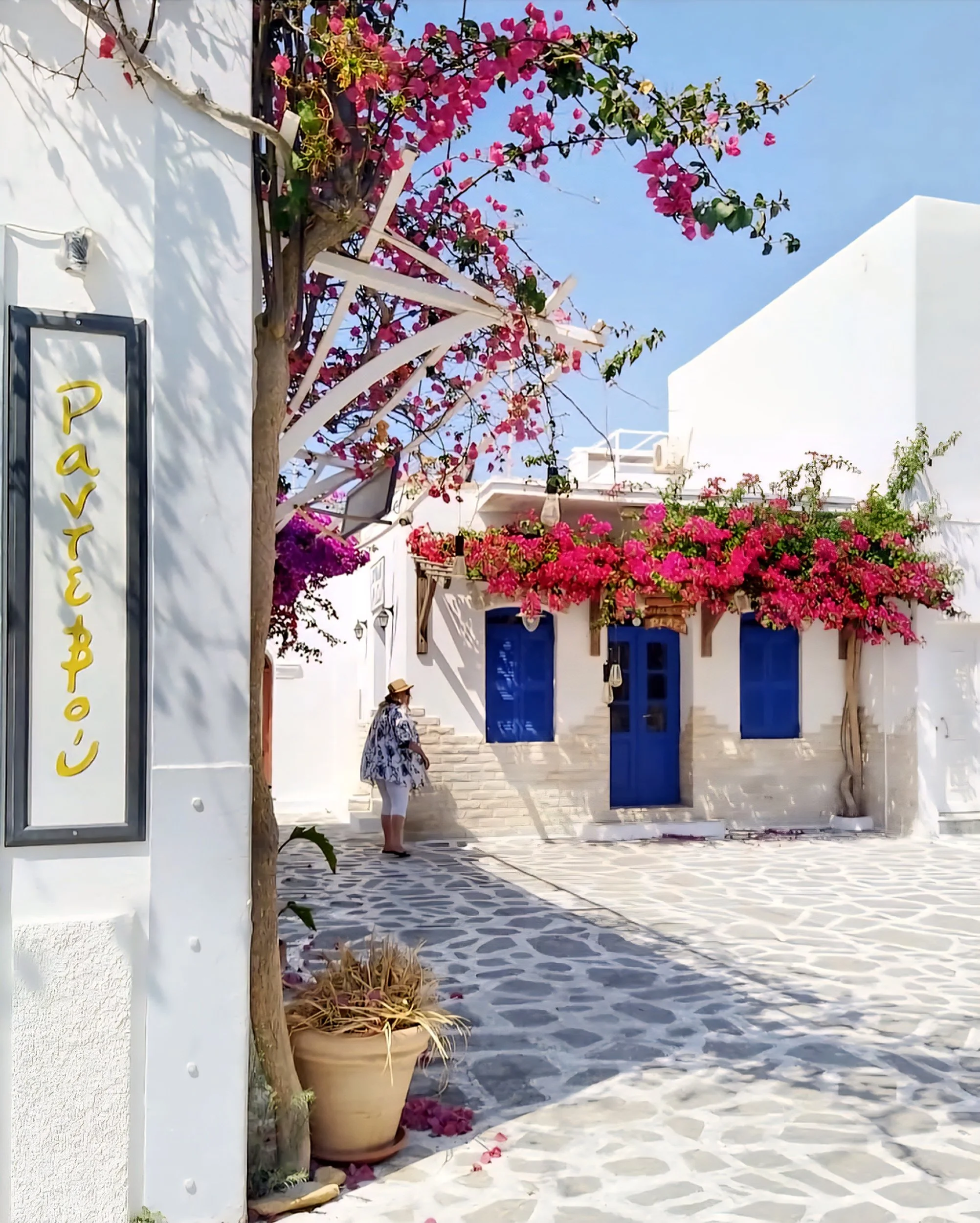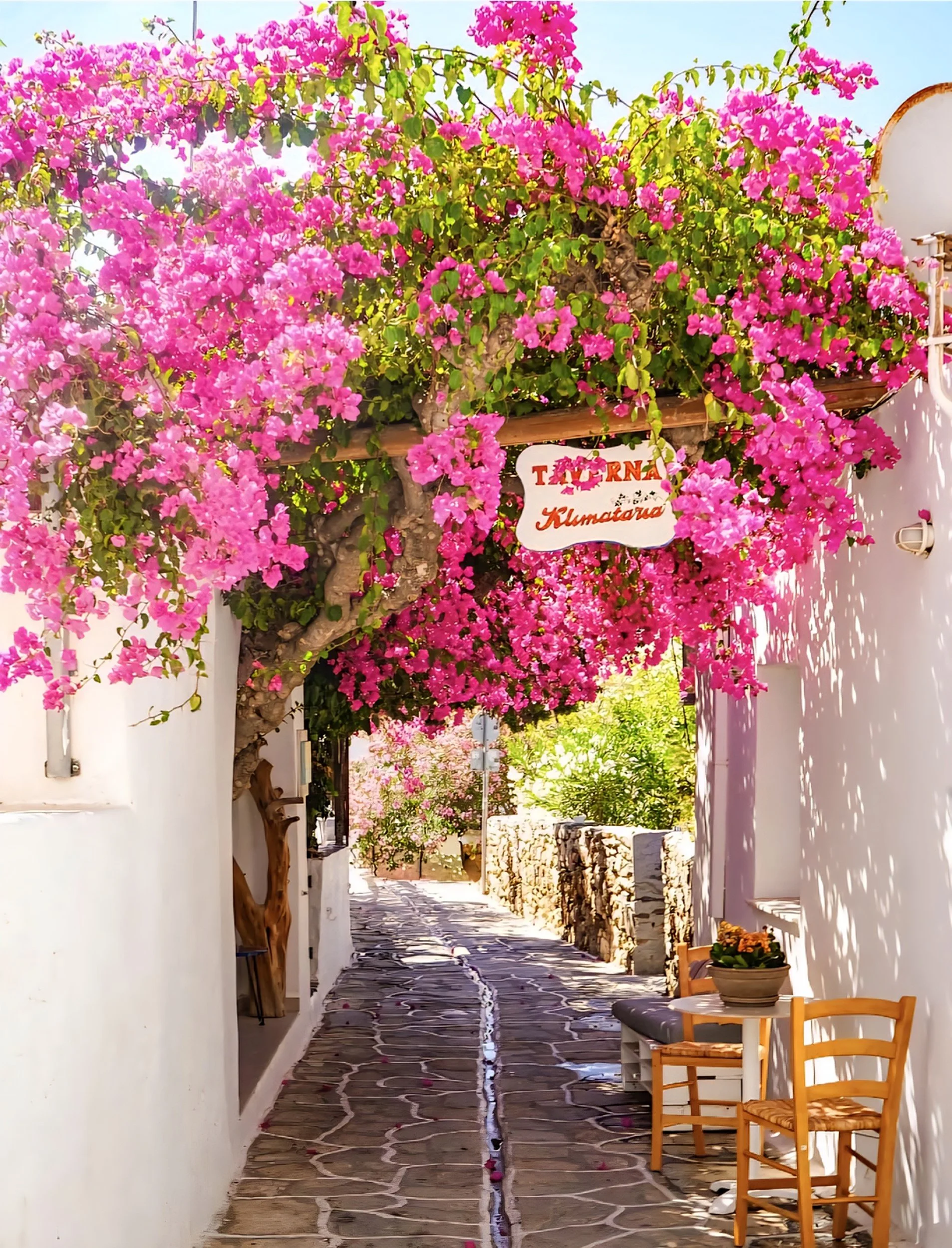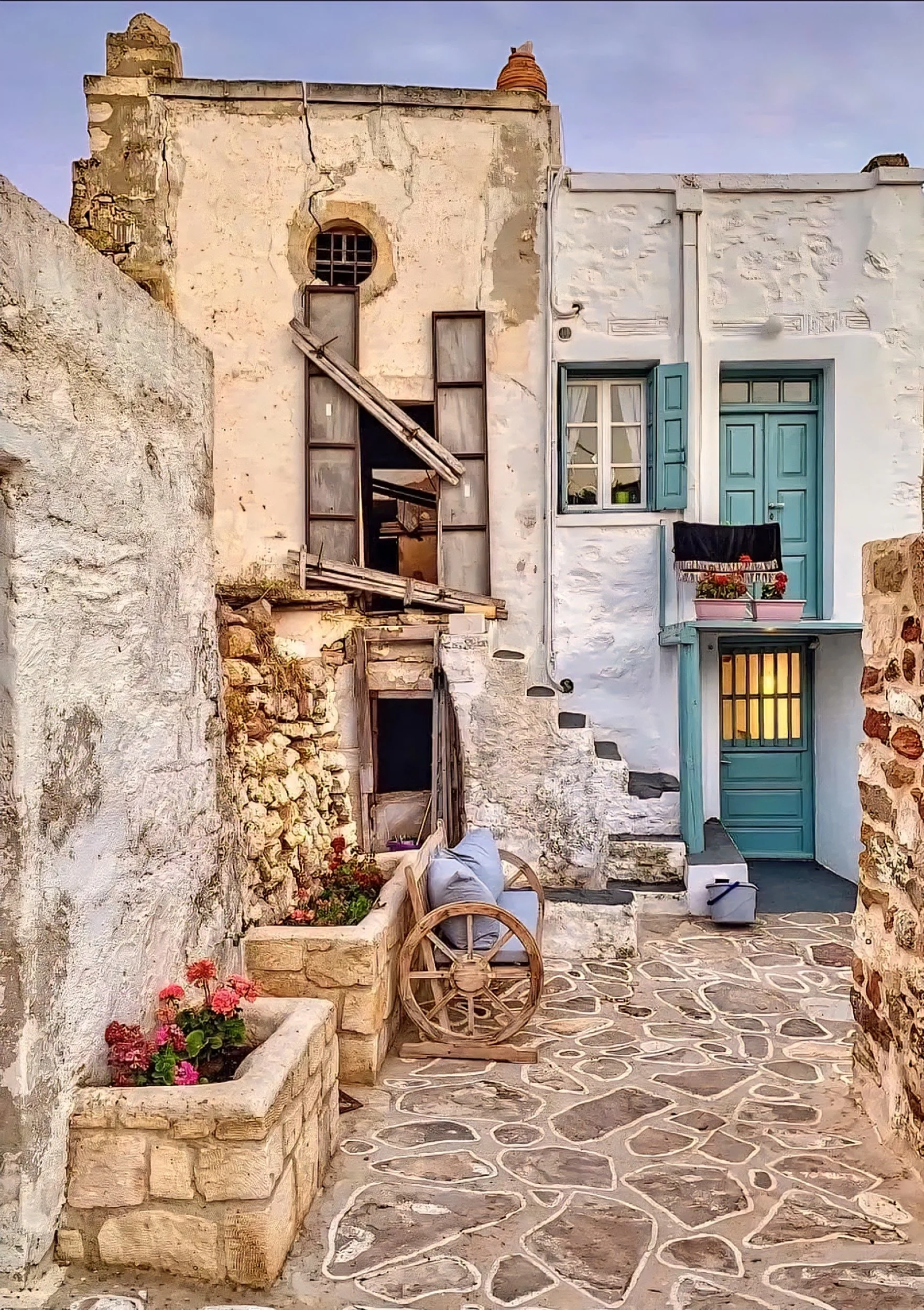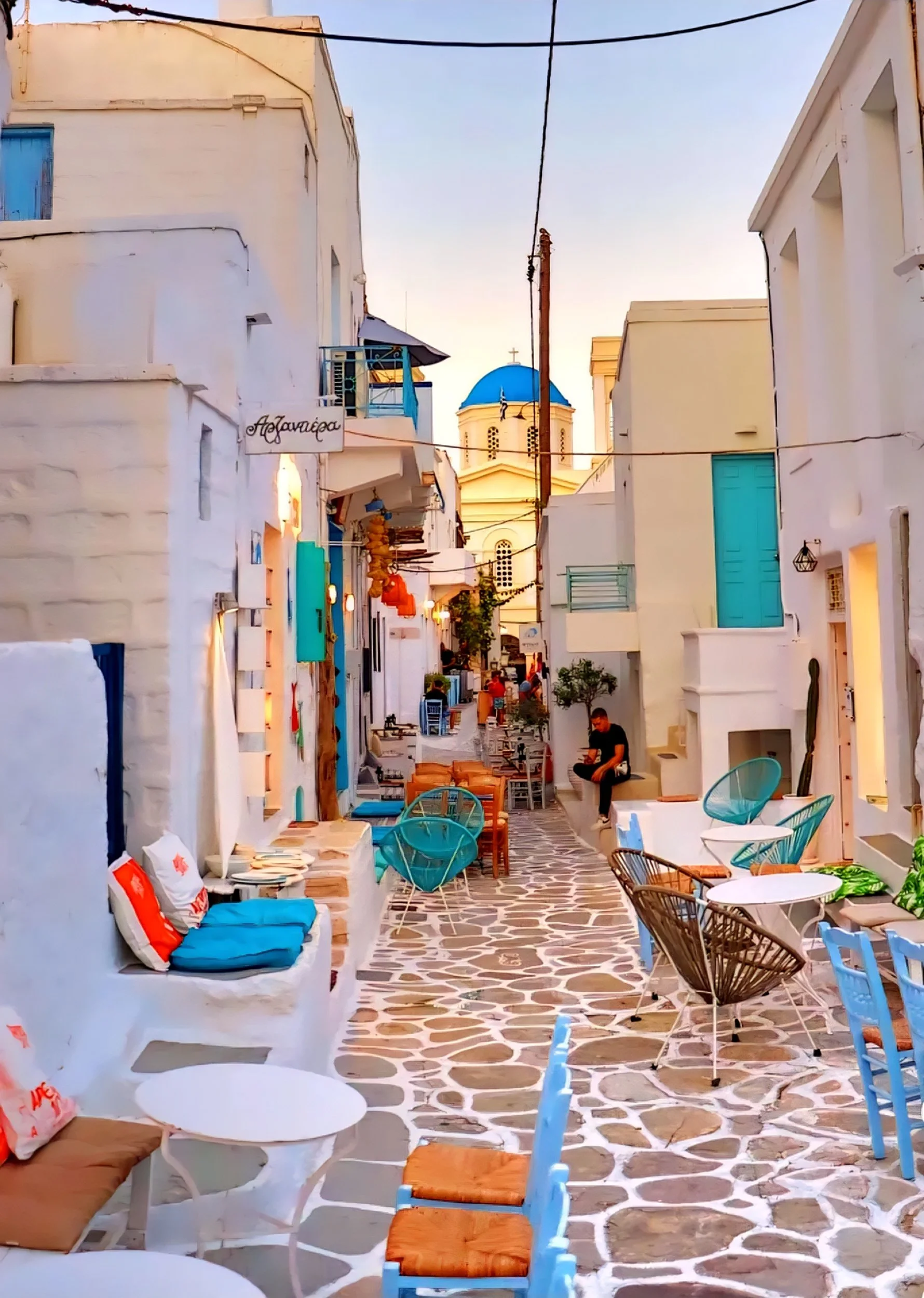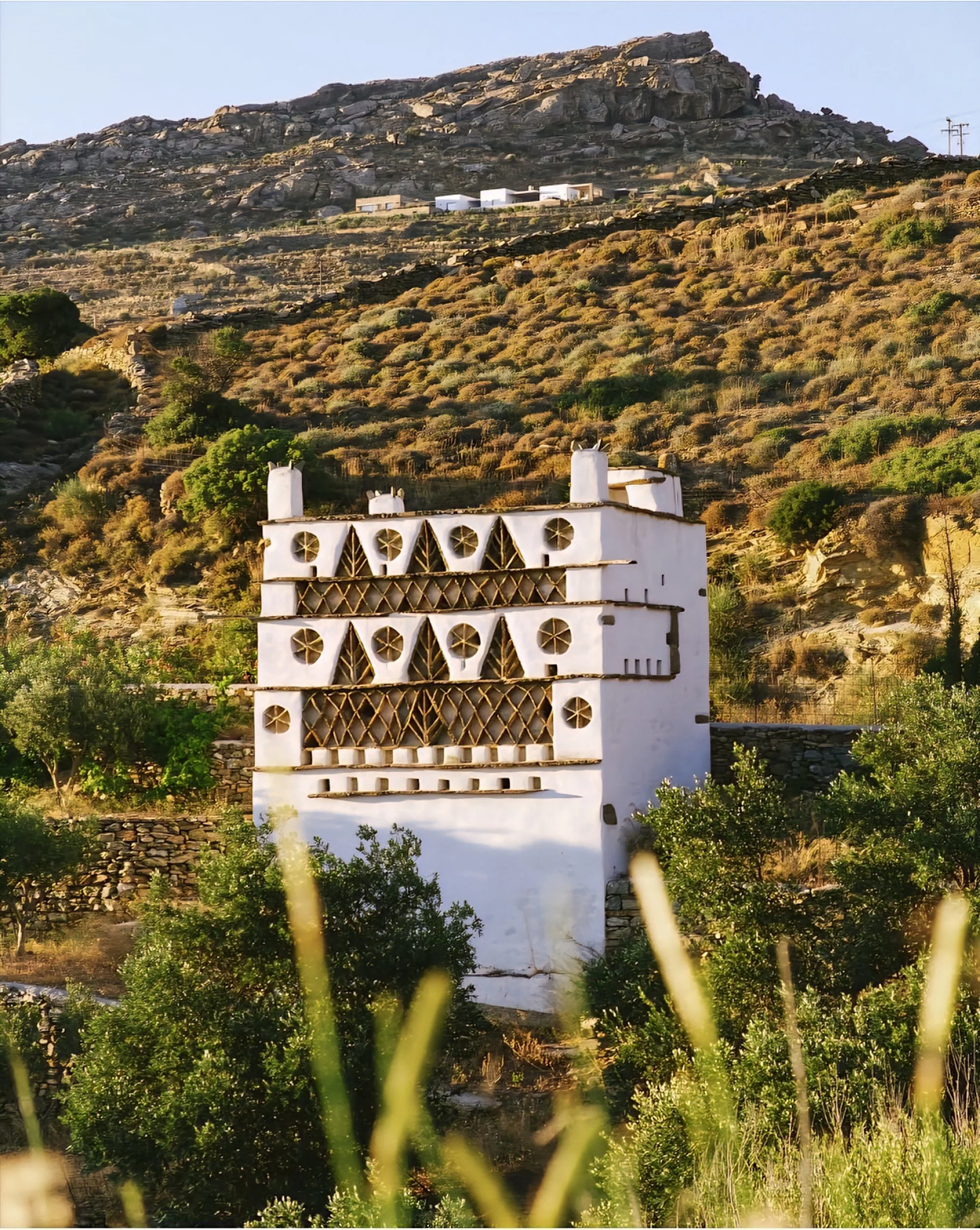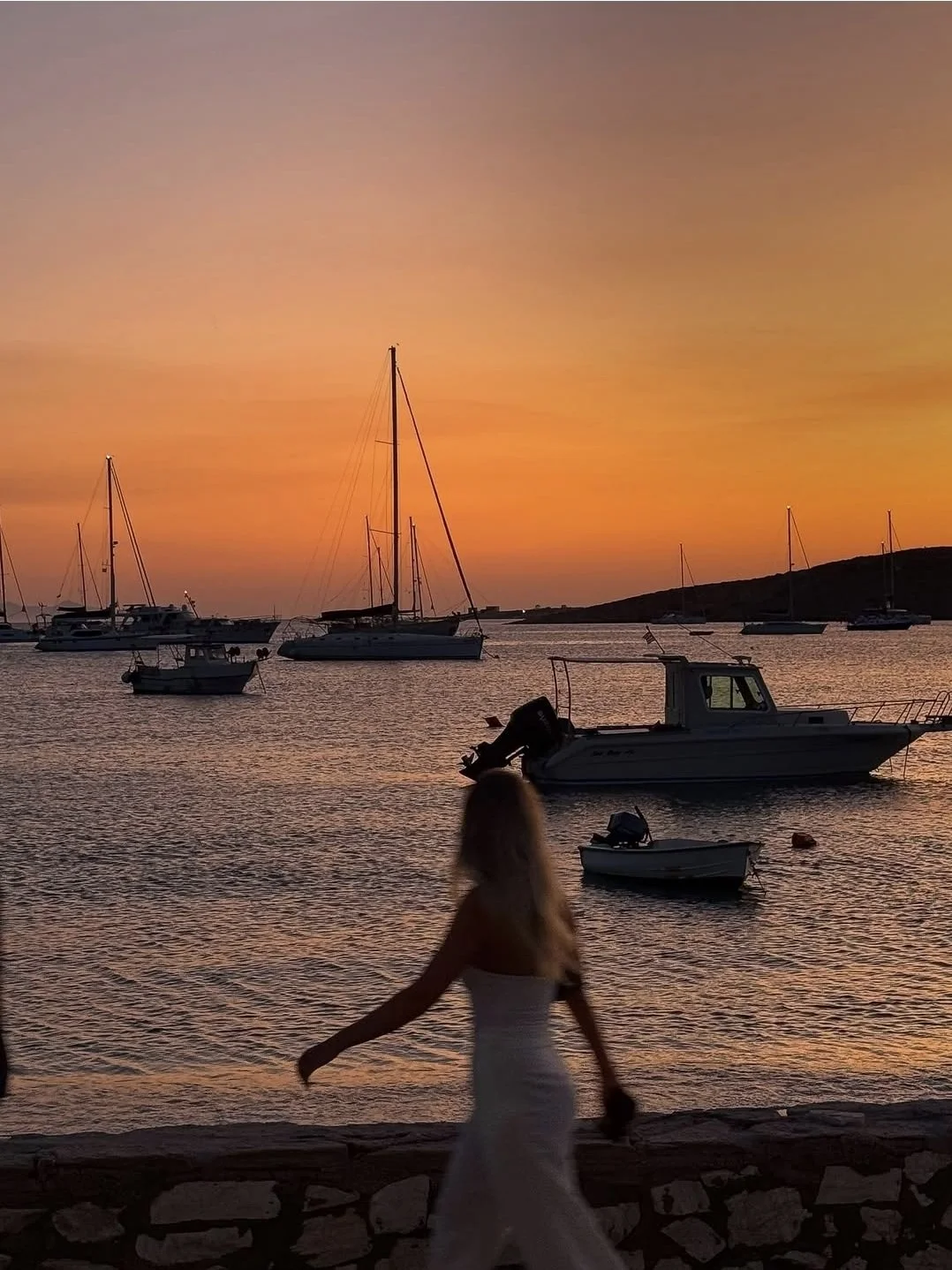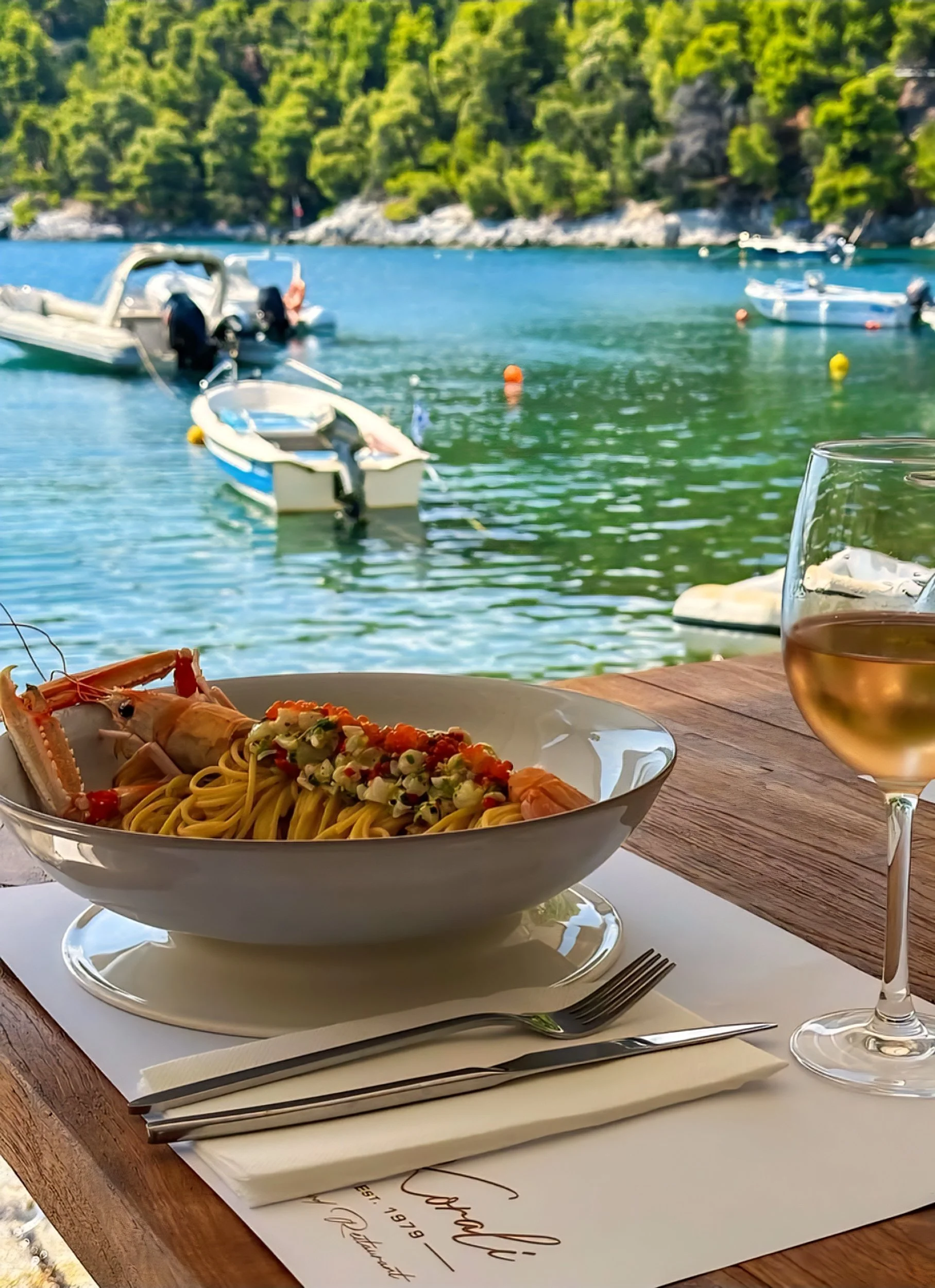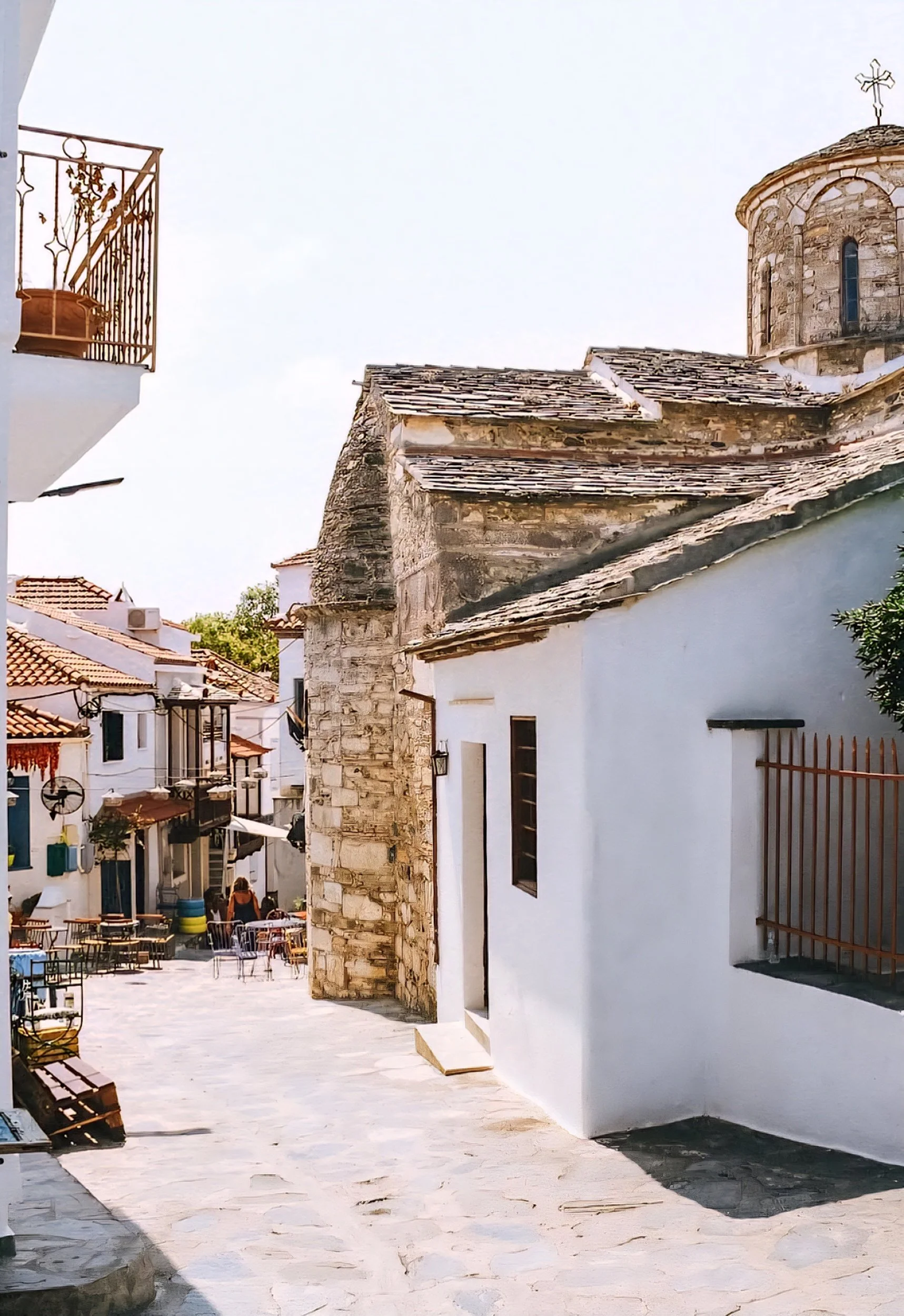Whitewashed Lanes & Golden Light: Quiet Greek Islands to Visit This Autumn
The ferry slows as it approaches the quay, and a breeze heavy with sea salt brushes your face. You hear the hum of quiet conversation from a café terrace, the faint chime of church bells, and the gentle slap of waves against painted fishing boats.
It’s not the chaotic arrival you’d expect in Greece. No crowd pressing to disembark, no queue for the island’s “must‑see” photo spot. Instead, the view is pure calm - whitewashed houses spilling down toward the sea, marble staircases gleaming in the soft light, and balconies dressed in bougainvillea.
This is what the Greek islands feel like when you skip the tourist checklist and follow the rhythm of the place. Autumn (and the quieter months beyond) is when these villages return to themselves. The days are still warm enough for swimming, but the air has a softness to it. Locals linger in shaded squares, café tables sit empty enough to claim your favorite spot, and you have time (real, unhurried time) to notice the details.
And the details are what make these islands magic: neoclassical mansions with chipped shutters, hand‑carved marble fountains, Cycladic cubes wrapped in geraniums. You don’t just see the architecture here - you feel it in the way people live.
Forget Santorini for now. These five islands offer an architectural feast for the eyes and a slower way to savor it.
Syros: Neoclassical Grace in the Heart of the Cyclades
Syros doesn’t rely on dramatic cliffs or Instagram clichés: it’s quietly confident in its beauty. Ermoupoli, the island’s main town, was once the beating heart of Greek shipping, and it wears that history well. This is not the Cyclades of sugar‑cube houses tumbling into the sea. Instead, it’s a refined tapestry of 19th‑century neoclassical mansions in soft pastels, iron‑worked balconies with trailing geraniums, and marble staircases that gleam in the sun.
Walk along the waterfront and you’ll notice municipal buildings with intricate cornices and tall, arched windows, a style that feels more Riviera than Aegean. In the late afternoon, as the light turns honey‑gold, locals drift into Miaouli Square. Children weave between tables while friends linger over thick Greek coffee. The marble paving glows like polished stone, and the scene feels timeless.
If you love architecture, step inside the Apollo Theater - a miniature homage to Milan’s La Scala built in 1864. Even if there’s no performance, the red‑velvet seats, painted ceiling, and ornate balconies are worth the peek. Just a few streets away, Industrial Museum of Ermoupoli is a surprisingly fascinating stop. It showcases the island’s shipbuilding and textile past through beautifully preserved tools, maps, and even old diving suits.
For a slower afternoon, climb into Ano Syros, the medieval hilltop quarter where the mood shifts entirely. Here, the neoclassical elegance gives way to whitewashed Cycladic cubes clustered along narrow lanes scented with jasmine. Wander without a map and you’ll find tiny archways, pastel‑painted shutters, and little squares where time feels suspended.
Stop for a freddo cappuccino at Sta Vaporia, a tiny seaside café where your table is practically at the water’s edge. If you’re hungry, To Kastri in Ano Syros serves melt‑in‑your‑mouth local sausages and louza (cured pork) with crisp village bread. For something sweeter, look for a bakery selling loukoumi (Syros’ own take on Turkish delight) perfumed with rosewater or mastiha.
Boutique Stays:
Hotel Ploes – This is where you stay if you want to feel like part of Syros’ elegant past. A restored neoclassical mansion with soaring ceilings, hand‑painted details, and marble bathrooms, all perched right above the sea. The breakfast terrace is worth waking up early for - the kind of spot where you linger long after your coffee is cold.
Diogenis Hotel – Housed in a historic stone building across from the harbor, Diogenis has that understated charm you only find in well‑loved old hotels. Rooms have high ceilings and a hint of maritime flair, and you can watch ferries glide in while you sip ouzo on the balcony.
Apollonion Palace – Another waterfront gem, with rooms that mix antique furniture and plush fabrics. Some balconies feel almost close enough to dip your toes into the water, and the sunset views are among the best in Ermoupoli.
If you’re an art lover, Syros has a thriving cultural calendar well into autumn. Keep an eye out for small concerts at Apollo Theater, film screenings in hidden courtyards, or temporary exhibitions at the Cyclades Art Gallery: a beautiful neoclassical space that’s as worth visiting for its architecture as for its art.
Antiparos: The Venetian Quarter’s Quiet Charm
Antiparos wears two faces. In July and August, its harbor hums with stylish Athenians in linen shirts, boutique‑shopping holidaymakers, and the occasional celebrity yacht anchored just offshore. But come September, the tempo drops. By October, the island settles into a softer rhythm: fishing nets drying on the quay, shutters thrown open to let in the last warm breezes, and the quiet clink of coffee cups in shaded lanes.
The heart of this slower Antiparos lies in the Kastro, the Venetian castle quarter. Built in the 15th century to protect residents from pirate raids, its outer ring of cube‑shaped houses still hugs narrow lanes like a protective wall. The white walls here are weathered from decades of sun, their limewash softening into a gentle matte glow. Shutters come in deep Cycladic blues, dusty mint greens, and the occasional rust red, a quiet reminder of the island’s layered history.
Turn a corner and you might find a tiny arched passageway opening into a sunlit courtyard - just big enough for a pair of café tables and a few terracotta pots spilling over with geraniums. One of the joys of wandering here is stumbling across small everyday moments: a cat stretching in a patch of sunlight, an elderly man repainting a door frame, or the smell of fresh bread drifting from a bakery you can’t quite locate.
Pause at Boogaloo Café, where mismatched chairs spill into the alley and the air is thick with the smell of freshly ground coffee. This is prime people‑and‑cat watching territory, and if you linger long enough, the locals will start greeting you as they pass. In late afternoon, stroll down to the harbor. You’ll likely find fishermen returning in their small wooden caiques, the day’s catch displayed on deck, and strings of octopus draped like laundry to dry in the golden light.
If you’re in the mood for a quiet drink or a plate of mezze, Yam serves cocktails and light bites in a laid‑back, softly lit courtyard. For something more traditional, Captain Pipinos, just a short drive away, is a simple taverna at the water’s edge where the grilled fish tastes like it came out of the sea minutes earlier.
Cozy stays:
Rooster Antiparos: A luxury eco‑retreat tucked in the dunes south of town, blending Cycladic minimalism with earthy, natural tones. Each suite feels like a private hideaway, and the on‑site restaurant serves seasonal dishes that make the most of island produce.
Kastro Antiparos Boutique Hotel: Just steps from the Venetian quarter, with bright white interiors, hand‑crafted décor, and balconies that frame the terracotta rooftops of the old village. Ideal if you want to be in the heart of the action but still retreat to calm at night.
Kimolos: Stone Lanes and Windmill Views
Kimolos is the kind of island where time doesn’t just slow down - it stretches. It’s small enough that you can walk from one end to the other in a day, yet every few steps seem to hold another reason to pause. The main village, Chorio, is a quiet maze of stone‑paved lanes lined with pastel‑painted shutters, weathered wooden doors, and archways draped in trailing bougainvillea. Here, even the smallest details feel steeped in history, like a carved lintel above a doorway, a faded sign from a shop that closed decades ago, the cool shade of a narrow alley offering a moment’s respite from the midday sun.
Above the village, a ring of old windmills stands sentinel on the ridge, their cylindrical shapes catching the last of the afternoon light. From here, you can take in views of patchwork fields, the terracotta‑tiled rooftops of Chorio, and the endless cobalt sweep of the Aegean. In autumn, the air carries a soft scent of wood smoke as locals stoke their outdoor ovens for slow‑cooked stews: lamb with lemon and herbs, or chickpeas baked overnight in clay pots.
Kimolos rewards unhurried exploration. A short stroll from Chorio will bring you to the Archaeological Museum, a tiny but fascinating space showcasing pottery and artifacts that tell the story of the island’s centuries‑old seafaring and agricultural traditions. If you’re visiting in October, you might stumble upon a village celebration where neighbors share homemade wine and plates of warm bread fresh from the oven.
Down at the tiny port of Psathi, life moves at an even gentler pace. Fishing boats rock lazily in the harbor, and a handful of seaside cafés offer the perfect excuse to linger. One of the most charming is To Kyma Café, where a few tables perch so close to the water that a passing boat might sprinkle your ankles with sea spray. Order loukoumades (honey‑soaked doughnuts topped with a dusting of cinnamon) and watch the light shift across the bay until the sky turns shades of peach and lavender.
For a taste of the island’s culinary soul, seek out Meltemi Restaurant in Chorio. It’s family‑run, with tables spilling onto the lane, serving locally caught fish, island cheeses, and vegetables from their own garden.
Cozy stays:
Kimolos Houses – Restored village houses turned into stylish self‑catering stays, complete with thick stone walls, wood‑beam ceilings, and sunny terraces ideal for slow breakfasts.
Psathi Blue – A boutique guesthouse right on the seafront, with airy white‑on‑white interiors and a focus on long, lazy mornings. Breakfast is served on your terrace, with the sound of the waves as your soundtrack.
Tinos: Marble Villages and Sculpted History
Tinos has an artistic soul carved in stone. Known as Greece’s marble island, it’s a place where craftsmanship is woven into everyday life. Even the humble pigeon houses (dotting the hillsides in white‑washed clusters) are miniature works of art, adorned with geometric carvings, stylized hearts, and tiny star motifs that have been passed down through generations of local stonemasons.
The village of Pyrgos feels like stepping into a living gallery. Every doorway, window frame, and fountain is edged in finely carved marble, so intricate you’ll find yourself slowing down just to admire the details. Workshops spill out onto the narrow streets, and in autumn, you might catch artisans chipping away at blocks of pure white marble, the soft dust catching the sunlight. In the shady main square, beneath the protective spread of a centuries‑old plane tree, locals and visitors gather at Kentrikon Café for thick, sweet Greek coffee or a glass of ouzo. From your table, you can watch as marble shavings drift like snow from the hands of nearby sculptors.
A short drive away, Kardiani perches like a balcony over the sea. The approach alone is worth the trip: winding roads open onto views of endless blue, with the village spilling down the hillside in a cascade of white houses and stone mansions with green shutters. In autumn, the scent of figs and fresh‑baked bread lingers in the lanes, and the pace slows to match the season. Kardiani’s shaded squares are perfect for lingering over a plate of louza (cured pork) or xinotiri (a local tangy cheese) at a small taverna, while taking in the wide‑open views toward Syros.
Art lovers will find their way to the Museum of Marble Crafts in Pyrgos, which brings the island’s sculpting tradition to life with beautifully displayed tools, models, and historic pieces. For a more personal experience, stop by a working studio - many sculptors are happy to chat about their process if you show genuine interest.
For a quiet, traditional meal, To Thalassaki in the tiny fishing village of Isternia Bay offers seasonal dishes right at the water’s edge, with tables so close to the sea you can hear the pebbles shifting beneath the waves.
Cozy stays:
Under the Sun Cycladic Village: Minimalist suites built into the hillside, with wide terraces that spill out toward sweeping views of the Aegean. Designed for privacy and stillness, perfect for long mornings with coffee and a book.
Crossroads Inn: A family‑run boutique stay in a restored village house, furnished with antique pieces and warm textiles. Known for its heartfelt hospitality and insider tips on where to explore away from the crowds.
Looking for more cozy travel ideas?
Sign up for the Trippers Terminal newsletter to get new destination guides, slow travel tips, and peaceful escape ideas sent straight to your inbox.
Skopelos: Green Slopes, White Chapels, and a Slower Rhythm
Skopelos has a way of wrapping itself around you. Known as the greenest island in the Aegean, it’s a tapestry of pine‑clad hills rolling down to pebbled coves and turquoise bays. In autumn, the summer buzz fades, and the island takes on a softer, quieter rhythm - perfect for solo travelers who want to sink into a slower pace.
The main town, Chora, is a cascade of whitewashed houses tumbling down the hillside toward the harbor, their terracotta roofs glowing warm against the green slopes. Narrow lanes weave between stone staircases and blooming courtyards, often opening unexpectedly onto tiny squares where a single kafeneio serves coffee to a handful of locals. In the upper part of town, the Venetian Castle ruins offer sweeping views across the harbor, the surrounding olive groves, and the glittering Aegean beyond.
Scattered across the island are more than 300 white‑washed chapels, some perched on rocky outcrops overlooking the sea, others tucked deep among pine forests. The most famous is Agios Ioannis Kastri: the tiny clifftop church made iconic by Mamma Mia!. Even if you’re not a film fan, the climb up its 100 stone steps rewards you with an almost cinematic view of the turquoise waters below. In autumn, you may have it nearly to yourself.
Food here is as much a reason to visit as the scenery. For something cozy and local, Agnanti in the hilltop village of Glossa serves Skopelitan specialties with sweeping views over the sea. Their Skopelos cheese pie (a crispy spiral of flaky pastry filled with tangy cheese), is a must‑try. Down by the harbor, Finikas offers fresh‑caught fish grilled to perfection, best enjoyed with a glass of chilled retsina as fishing boats bob just meters away.
Art and craft lovers should wander into Vakratsa Mansion Museum, a restored 18th‑century home in Chora that gives a glimpse into island life during the era of wealthy sea captains. You might also find small galleries tucked into whitewashed corners, showcasing pottery, painting, and handwoven textiles by local artisans.
Cozy stays:
Adrina Beach Hotel: A peaceful beachfront escape with rooms that open directly to sea views. The private beach is a quiet retreat, even in the warmer months.
Mando Beachfront: A boutique guesthouse set right on the sand, with a few charming rooms and a shaded terrace that makes a perfect morning coffee spot.
Why travel here in the autumn
When summer’s frenzy fades and the last of the beach umbrellas are packed away, these islands seem to exhale. The streets, once a blur of flip‑flops and camera flashes, return to their natural rhythm. You hear the echo of your footsteps in narrow alleys, the creak of a wooden door opening slowly in the morning sun, and the low murmur of neighbors greeting each other as they pass.
Without the distraction of constant movement, the architecture feels more alive. You notice the delicate curve of an old balcony railing, the fine etchings in a marble lintel, or the way sunlight slides across a neoclassical façade, turning pale stone to soft gold. In villages where time is measured not by clocks but by the sound of shutters opening in the morning and closing again at dusk, there’s a deep comfort in simply being still.
Cafés don’t vanish with the high season here. In fact, many stay open well into autumn, especially in places where locals still gather every evening for a slow drink and conversation. You might find yourself the only visitor in a harbor‑side kafeneio, sipping Greek coffee while watching fishermen mend their nets. The ferries, too, take on a gentler pace - no longer packed to the railings, but gliding from port to port with the unhurried assurance of those who know the sea.
It’s in these months that you catch glimpses of the real Greece. The one where an elderly shopkeeper will chat with you about the weather for twenty minutes, where you can linger over lunch without feeling the table needs to be cleared for the next booking, and where even the smallest, most unassuming taverna might serve the best meal of your trip. It’s Greece without the rush… and once you’ve experienced it, you may never want to visit any other way.
FAQ: Quiet Greek Islands & Architecture in Autumn
Which quiet Greek island is best to visit in October for Cycladic architecture?
Syros is your best bet. Ermoupoli’s neoclassical mansions and marble‑paved squares stay lively year‑round thanks to the island’s permanent population, so cafés and bakeries don’t close when the tourists leave. You’ll also find Ano Syros (a perfectly preserved medieval hilltop village with winding whitewashed lanes) all to yourself in October.
Is Tinos worth visiting in November for architecture and quiet villages?
Yes. Tinos is a marble‑sculptor’s paradise, and villages like Pyrgos and Kardiani are magical in November’s golden light. Most tourists are gone, but the island’s craft workshops, traditional cafés, and small guesthouses are still open because locals live here year‑round.
Are hotels open on Antiparos in late October?
Most hotels on Antiparos close by mid‑October, but a few boutique stays in the Kastro area (like Kastro Antiparos Boutique Hotel) keep their doors open until the end of the month. If you’re traveling late in the season, email them directly to confirm before booking.
Does Kimolos have restaurants open in autumn?
Yes, but fewer than in summer. In October you’ll still find a couple of family‑run tavernas in Chorio serving homemade stews and grilled fish, plus cafés in Psathi for coffee and loukoumades. By November, options are limited, so plan around the few spots that stay open year‑round.
How to get from Athens to Syros in autumn?
From Piraeus Port, ferries to Syros run several times a week in autumn (around 3.5–4 hours). Blue Star Ferries maintains the most reliable schedule outside summer. Flights from Athens are also available year‑round and take just 35 minutes — ideal if you’re short on time.
Can I photograph Greek island architecture without tourists in the shot?
Yes, and autumn makes it easy. In Ermoupoli, head to Miaouli Square early in the morning for empty marble steps. In Tinos, visit Pyrgos just after sunrise for golden‑lit marble doorways and quiet alleys. Even popular harbors like Antiparos are empty just after the fishing boats return in late afternoon.

